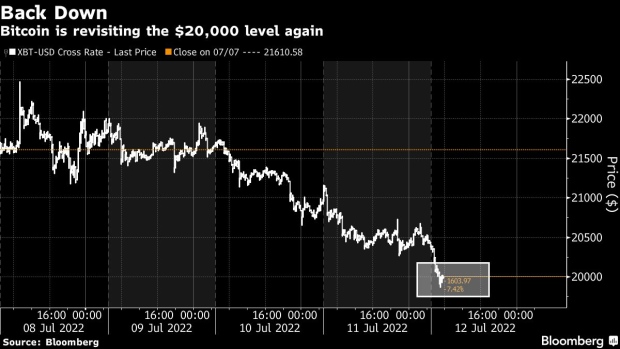Jul 11, 2022
Bitcoin drops for a fourth day, falling back below US$20,000 level
, Bloomberg News
Cryptos Face Downside Momentum: Fairlead Strategies
Bitcoin fell back below US$20,000 on Tuesday after enjoying its strongest run in more than three months last week, as risk aversion returned to global markets.
The largest cryptocurrency dropped as much as 5.6 per cent to US$19,275, declining for a fourth straight session. It reached US$22,472 on Friday amid a broader rally. Second-largest Ether tumbled more than 9 per cent to US$1,032. The MVIS CryptoCompare Digital Assets 100 index dropped 5.1 per cent, and traded near session lows.
“I’m not surprised to see prices going down with commodity prices and the overall sense of weakening growth -- money being tighter and there’s less money to slosh into crypto,” Brian Nick, chief investment strategist at Nuveen, said in an interview. “That’s not a shock. There’s a lot of volatility.”

US stocks slumped ahead of a key inflation report, with the Treasury curve inversion deepening to levels last seen in 2007 amid fears that rate hikes will sink the economy into a recession.
Bitcoin has been trading range-bound since its steep drop in June, hovering just around US$19,500, its 2017 peak. If the coin breaks below this level, US$16,000 to US$17,000 may act as the next level of support, the range Bitcoin saw as resistance during the relief rally in early 2018. Or it could move toward US$14,000, the coin’s peak in 2019, according to Arcane Research.
If, however, Bitcoin breaks higher, US$28,000 may serve as the nearest resistance area, which is the coin’s bottom in 2021, Arcane added.
Still, many investors watching the space aren’t feeling so bullish. Bitcoin is more likely to tumble to US$10,000, cutting its value roughly in half, than it is to rally back to US$30,000, according to 60 per cent of the 950 investors who responded to a Bloomberg MLIV Pulse survey that ran July 5-8. Forty percent saw it going the other way.
Meanwhile, there’s a sense of hodling -- or holding onto investments even during tough times -- among the crypto faithful. On-chain data suggests that such investors have been undeterred by recent market dynamics, according to Strahinja Savic at FRNT Financial. The percentage of Bitcoin that hasn’t moved for more than a year reached an all-time high of 66 per cent in June, and has remained steady at around 65 per cent now.






